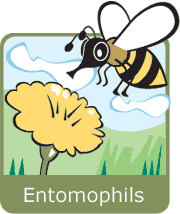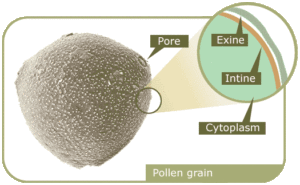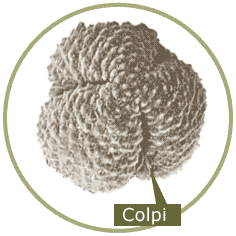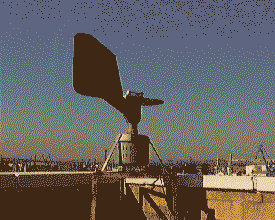Introduction
Pollen is the vehicle for the male gamete of plants, and needs to be transported to the female gamete in order to fertilize it, and consequently, in order to ensure the survival of the plant species. With this aim, plants mainly use two strategies, in accordance with which plants can be classified:
 Entomophils (from the Greek Entomos = insect) ➜ these plants reproduce themselves by means of insects. These usually have very eye-catching and beautiful flowers in order to attract insects, and so their pollen is normally quite sticky. When a insect alights on a flower to suck the nectar, pollen sticks to the hair on its legs. Then, when the insect goes to another flower, some of this pollen sticks and thus fertilises the plant.
Entomophils (from the Greek Entomos = insect) ➜ these plants reproduce themselves by means of insects. These usually have very eye-catching and beautiful flowers in order to attract insects, and so their pollen is normally quite sticky. When a insect alights on a flower to suck the nectar, pollen sticks to the hair on its legs. Then, when the insect goes to another flower, some of this pollen sticks and thus fertilises the plant.- Anemophils (from the Greek Anemos = wind) ➜ these plants reproduce themselves by means of the wind. They do not have beautiful flowers, because they do not need to attract insects. So, they usually have small pollen, that comes off very easily and in great quantities when the wind blows, and is carried by the wind great distances (“aero-roaming”), thus permitting the fertilisation of other plants of the same species.
Several plants have a mixed form of fertilization (anemophil and entomophil)
From this point, and taking into account that people become allergic by breathing pollen floating in the wind, it is easy to infer a series of very interesting aspects:
 From an allergologic point of view the most important are Anemophil plants, because their pollen will be present in the air in very high quantities, and consequently the more anemophils, the more allergologic. So, pollen from plants with beautiful flowers (Entomophils such as roses, carnations, etc.) do not normally produce allergy, because their pollen does not travel in the air so easily.
From an allergologic point of view the most important are Anemophil plants, because their pollen will be present in the air in very high quantities, and consequently the more anemophils, the more allergologic. So, pollen from plants with beautiful flowers (Entomophils such as roses, carnations, etc.) do not normally produce allergy, because their pollen does not travel in the air so easily.- The most common symptoms in people allergic to pollen are respiratory symptoms, because airways are the ways through which the person enters into contact with pollen: Conjunctivitis (itchy eyes, tears,…), Rhinitis (sneezing, nasal obstruction, itchy nose,…), and lower airway symptoms (cough, asthma,…). Sometimes wheals and swelling can also appear.
- Generally speaking, spring and summer is usually the worst time of the year for people allergic to pollen, because this is when plants normally pollinate, although it is neither exclusive to this season nor inevitable, depending as it does on the kind of plant responsible for the pollen that causes the allergy.
- Windy days are the worst for people allergic to pollen because this is when anemophil plants give off the greatest quantities of pollen to the atmosphere. In coastal areas, days when the wind blows from inland (i.e.: west wind in eastern coasts, north wind in southern coasts, etc.).
- People allergic to pollen usually improve during rainy weather because rain helps to “clean” the atmosphere.
- It is probable that a patient allergic to pollen will become worse when he/she is in a geographical area where they are many plants to whose pollen he/she is allergic. However, this does not guarantee that when the patient is far away from these areas, that he/she will be free from problems, because pollen can be transported by the wind many dozens of kilometres.
- There is no generic allergy “to pollen”, and allergy to pollen is specific to each plant: for example, there are people allergic to olive tree pollen who tolerate birch pollen perfectly well; people allergic to grass pollen who tolerate cypress pollen, etc. So, for an appropriate treatment, it is absolutely essential to diagnose which type of pollen is responsible for the patient’s problem in order to establish a specific treatment.
- The specific treatment for pollen allergy is Vaccination. It has been clearly demonstrated that this treatment is highly effective for controlling patients allergic to pollen, provided that the pollen responsible for the patient’s symptoms has been properly diagnosed, and a high quality Vaccine is administrated regularly, and over an adequate period of time.
BRIEF DESCRIPTION OF A POLLEN GRAIN
Pollen grains are microscopical structures, commonly with a diameter of 10 to 60 microns (µm), and usually round or ovoid, inside which the reproductive material is located. In order to protect such material, pollen is covered by two protective membranes: one external (the EXINE)), the other internal and thinner (the INTINE)

 Neither the Intine nor the Exine are insurmountable barriers, because they must allow the passage of the genetic material when the plant is fertilised. This occurs through PORES, or through elongated furrows, called COLPI). Depending on the number of Pores a pollen has, it can be classified as Monoporated, Biporated, Triporated, Multiporated, etc. If pollen has Colpi, it will be Monocolpated, Bicolpated, Tricolpated, etc. Pollen frequently have both Pores and Colpi, and in this case they will be “Colporated” (Monocolporated, Bicolporated, etc.). Some pollens apparently have neither Pores nor Colpi, and then they are “un-aperturated”. All these things help us to differentiate between different kinds of pollen with a microscope.
Neither the Intine nor the Exine are insurmountable barriers, because they must allow the passage of the genetic material when the plant is fertilised. This occurs through PORES, or through elongated furrows, called COLPI). Depending on the number of Pores a pollen has, it can be classified as Monoporated, Biporated, Triporated, Multiporated, etc. If pollen has Colpi, it will be Monocolpated, Bicolpated, Tricolpated, etc. Pollen frequently have both Pores and Colpi, and in this case they will be “Colporated” (Monocolporated, Bicolporated, etc.). Some pollens apparently have neither Pores nor Colpi, and then they are “un-aperturated”. All these things help us to differentiate between different kinds of pollen with a microscope.
Furthermore, Exine (the outer surface) can have very different surface textures, and it is very easy to dye it. This also helps to distinguish pollens with a microscope:




There are many other textures, such as smooth, striated, perforated, wrinkled, etc.
The size of the pollen also helps to differentiate them. Depending on the size, they can be classified as:
Very small ➜ < 10 µm diameter
Small ➜ 10 – 25 µm diameter
Medium ➜ 25 – 50 µm diameter
Large ➜ 50 – 100 µm diameter
Very large ➜ 100 – 200 µm diameter
Giant ➜ > 200 µm diameter
We can collect pollen with special machines (see picture). This collector has a weathercock that orientates the nozzle to the direction of the wind. It also has a vacuum pump, that aspirates a constant flow of air through the nozzle. In this way, pollen impacts against a plastic ribbon soaked in silicone and placed on a cylinder that makes one complete revolution every week.
 The ribbon is changed every week, and is divided in segments corresponding to the days of the week. Every fragment is put on a glass plate, then it will be dyed, and so we can see it with a microscope, identify and count pollens. In this way, we can not only count the concentration of each type of pollen in the air (counted in grains of pollen per cubic metre of air), but also know the day and even the time of these concentrations.
The ribbon is changed every week, and is divided in segments corresponding to the days of the week. Every fragment is put on a glass plate, then it will be dyed, and so we can see it with a microscope, identify and count pollens. In this way, we can not only count the concentration of each type of pollen in the air (counted in grains of pollen per cubic metre of air), but also know the day and even the time of these concentrations.
In “The most allergenic pollens” pages we will have a look at a brief explanation of the most important characteristics of some of the significant plants in Europe from an allergologic point of view, and of their pollens. You can also see similarities and differences between them. Additionally, you will be able to see the months and regions in Europe with higher levels of pollen for each group of plants.
